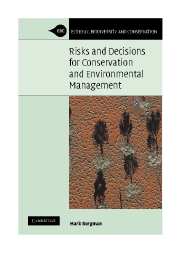Book contents
- Frontmatter
- Contents
- Preface
- Acknowledgments
- 1 Values, history and perception
- 2 Kinds of uncertainty
- 3 Conventions and the risk management cycle
- 4 Experts, stakeholders and elicitation
- 5 Conceptual models and hazard assessment
- 6 Risk ranking
- 7 Ecotoxicology
- 8 Logic trees and decisions
- 9 Interval arithmetic
- 10 Monte Carlo
- 11 Inference, decisions, monitoring and updating
- 12 Decisions and risk management
- Glossary
- References
- Index
8 - Logic trees and decisions
Published online by Cambridge University Press: 03 December 2009
- Frontmatter
- Contents
- Preface
- Acknowledgments
- 1 Values, history and perception
- 2 Kinds of uncertainty
- 3 Conventions and the risk management cycle
- 4 Experts, stakeholders and elicitation
- 5 Conceptual models and hazard assessment
- 6 Risk ranking
- 7 Ecotoxicology
- 8 Logic trees and decisions
- 9 Interval arithmetic
- 10 Monte Carlo
- 11 Inference, decisions, monitoring and updating
- 12 Decisions and risk management
- Glossary
- References
- Index
Summary
Logic trees are diagrams that link all the processes and events that could lead to, or develop from, a hazard. There are two approaches: a fault tree works from the top down, linking chains of events to the outcome (fault tree analysis); an event tree takes a triggering event and follows all possible outcomes to their final consequences (event tree analysis).
These approaches are best developed in engineering where they are used to formalize conceptual models. They are sometimes called cause-consequence diagrams (Hayes 2002a). Logic trees use the same structured reasoning that appears in diagrams of arguments in informal logic (Walton and Batten 1984) although argument diagrams are not usually causal (Korb and Nicholson 2003). Logic trees are also intimately related to expert systems.
This chapter describes event trees and their extensions into decision trees, decision tables and related methods. It introduces classification and regression trees, probabilistic trees and Bayes' networks. Lastly, it describes the structure and function of fault trees. Logic trees are pervasive, even if sometimes the trees are not drawn. Examples from conservation biology, toxicology, human health and safety, engineering, freshwater ecology and invasive species risk assessment illustrate their utility and limitations.
Event trees
Event trees link possible outcomes following an initiating event. They are constructed as a series of dichotomies (yes/no). Each node is an event (or a decision). The tree represents a model of the causal pathways for the system. The focus is on a primary (initiating) event and consequences are traced forwards from it.
- Type
- Chapter
- Information
- Publisher: Cambridge University PressPrint publication year: 2005



